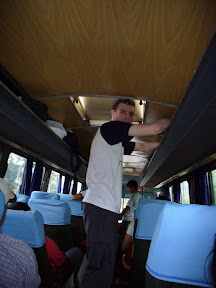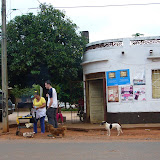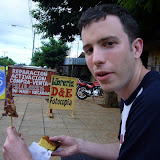
Aisle surfing like a boss. This bus was easy, there was added headroom so that I could standup straight! Possible downside: skull getting crushed when the bus rolls over.
Ok, I will admit it. Figuring out how to get from place to place during my trips is one of my favorite travel chores. Usually it is pretty simple since the guidebooks lay out most of the details. The process becomes a little more interesting when you have to go from one middle-of-nowhere place to another middle-of-nowhere place.
It took us a couple hours to get to San Ber which lies to the east of Asución and it is quite a ways from Route 1, Paraguay’s main north-south highway. Ybycuí is in roughly in same direction but a few more hours down the road. We didn’t really want to backtrack all the way to Asunción so we decided to ride one of the local buses (which doubles as a school bus!) back to Route 1 and then attempt to flag down an Ybycuí-bound bus.
In Paraguay, there aren’t fixed bus stops. Instead the protocol is to simply stand somewhere along their route and flail your arms as necessary until they stop. This makes them very convenient but it also means they stop about every quarter mile to load and discharge passengers!
Getting out of San Ber was a piece of cake. The wait was no more than 15 minutes for an Asunción-bound local bus(which double as school buses!). Based on the crude map in our guidebook we knew that we had to ride as far as San Lorenzo as that is the town where the highway splits off to head south towards Ybycuí. Figuring out where to get off was a bit of a guessing game but the driver helped us out.
The keeper of our guesthouse in San Ber told us that we had to “walk one block over” in San Lorenzo to find the Ybycuí buses. As it turned out, it was actually a few blocks away but Amy was able to ask a few locals to get more precise directions. Before we knew it we were standing with a bunch of Paraguayans eagerly awaiting their buses to the countryside.
It wasn’t more than 15 minutes until an ancient Mercedes bus rolled up to take is to Ybycuí. Public transportation in Paraguay is great!

Our ride to Ybycuí
Naturally, each and every seat was occupied when we boarded so we had to surf the aisle for a while. Amy got one after about 20 minutes and I scored one about an hour into the 4 hour ride to Ybycuí. Riding in the aisle isn’t terrible (especially given the condition of some of the “seats”) but it is annoying when all the chipá/banana/sock vendors push their way past you and your backpack so that they can attempt to make one last sale in the back of the bus.
By the time we got to Ybycuí few people remained and we jumped off with very little fanfare on a dusty corner in what we hoped was the center of town. Our guidebook claimed that there was one hotel in town and some other blogger wrote about a hospedaje. As luck would have it, the bus dropped us directly in front of both of them! Of course, we didn’t know that until we made a fool of ourselves by asking a nearby shopkeeper for directions. 
The town of Ybycuí was very quiet. Most of the businesses are located along the town’s one main street. There were plenty of shops selling clothing, a few groceries stores and even two internet cafes although the town was notably lacking in restaurants. I don’t remember seeing a single restaurant during our two-day stay. The only prepared food that we were able to find was from a lady selling grilled meat along the side of the road. It was there that I got to try my first sopa paraguaya along with some meat-on-a-stick. Sopa paraguaya is basically cornbread with onions and, optionally, cheese and meat.

Obtaining some street meat. Dogs filled with hope.
|

Meat on a stick and sopa paraguaya
|
